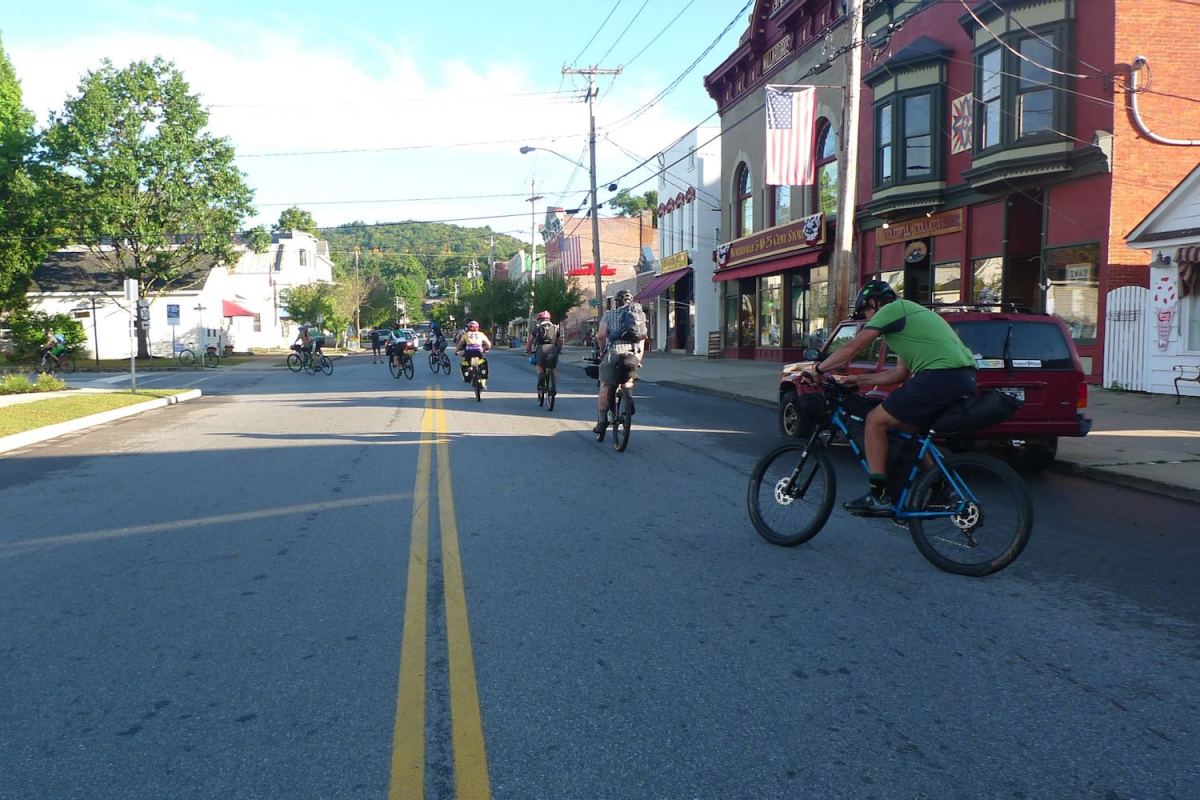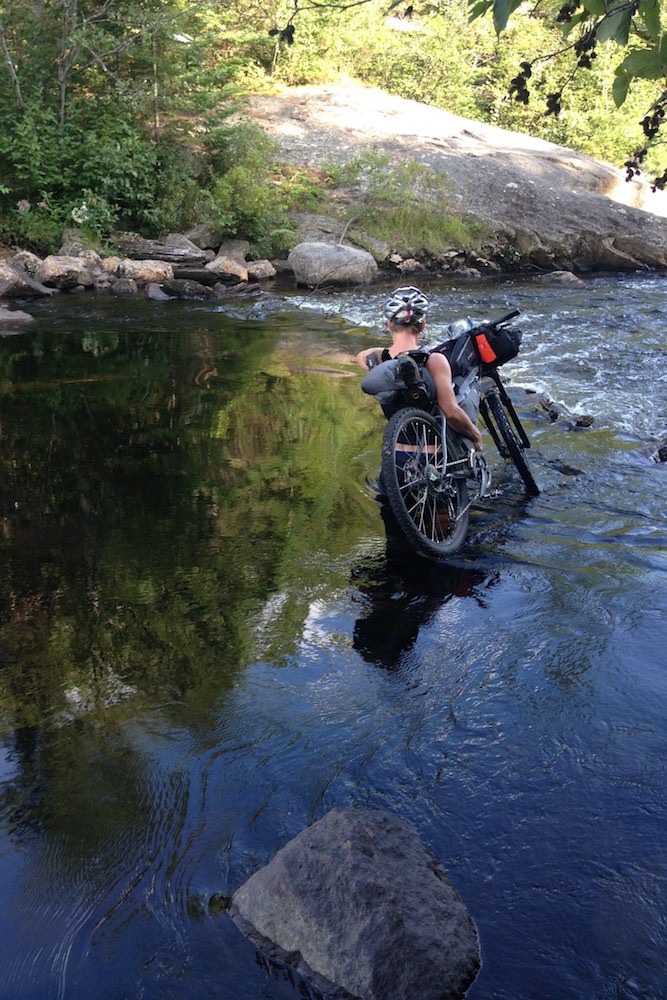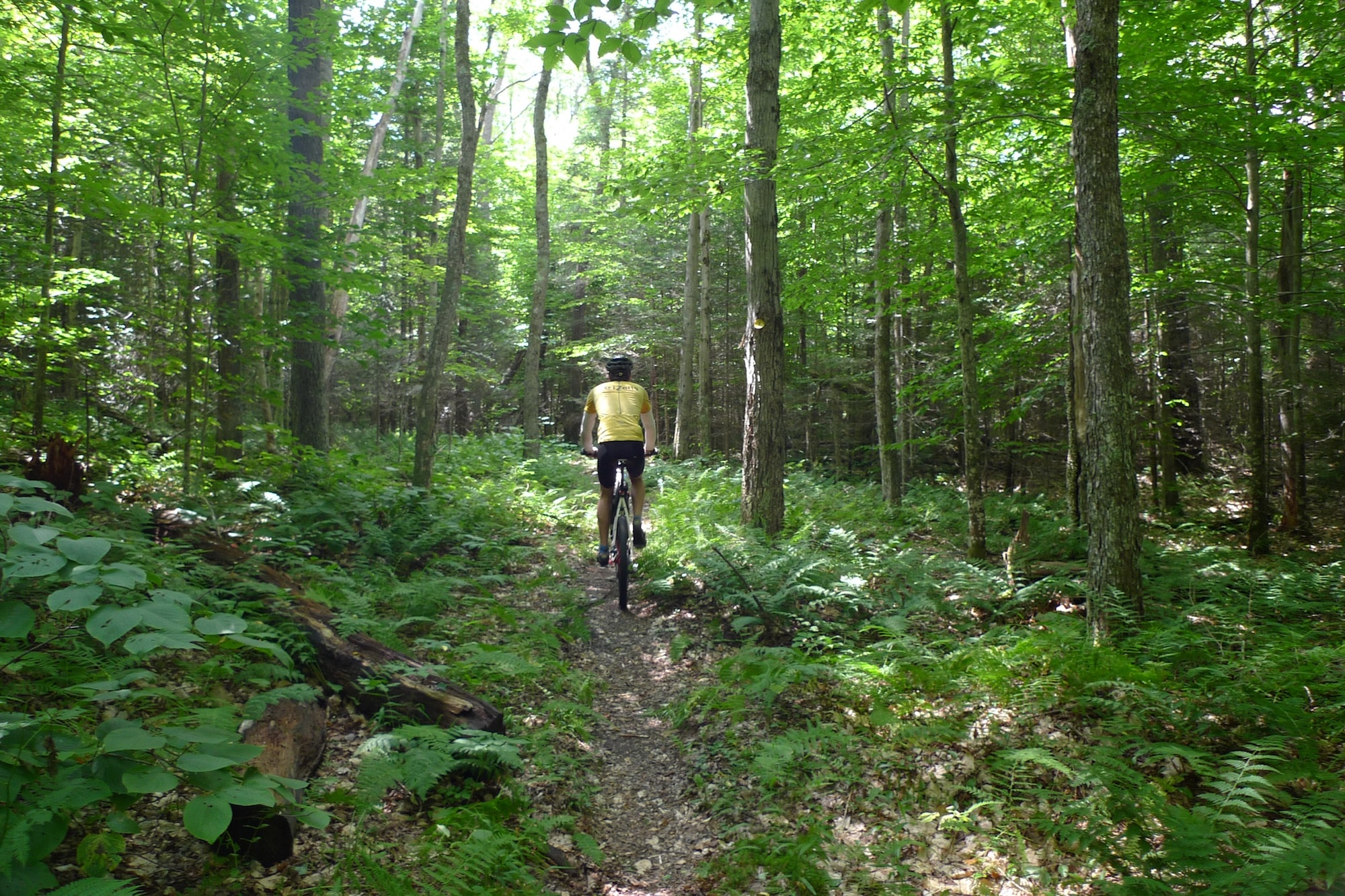On September 14, a dozen mountain bikers will assemble before dawn at Waterfront Park in Northville, New York, a village of 1,000 people in the Adirondack Mountain foothills. Michael Intrabartola, a carpenter who lives in the High Peaks region 90 miles north, will check in with each rider as they secure soft-sided bags to their seatposts, top tubes and handlebars.
When morning light sets turning maple leaves aglow, Intrabartola will send a friend to halt cars on Main Street and the small knot of cyclists will set off together, turn west and cross the Sacandaga River. At Route 30, the pack may stretch out as leaders surge toward root-snarled trails snaking through protected forests and soggy-bottomed tracks bordering backcountry lakes.
This scene marks the grand depart for The Adirondack Trail Ride (TATR), a 575-mile route with 51,650 feet of vertical gain. Intrabartola created TATR (say it: tate-r) by linking existing singletrack, doubletrack, dirt roads and the odd hike-a-bike or paved section to circumnavigate northern New York’s 6- million-acre Adirondack Park. For its fourth year, a field capped at 19 riders will join him for a multiday, self-supported mountain bike ride through remote terrain. Intrabartola tells TATR cyclists to prepare for a 10-day trip. Finish times in the ride’s three-year history range from three to 16 days, and the DNF (did not finish) rate is nearly 50 percent.

Photo Credit: Courtesy of Mikey Intrabartola
This type of ride is called bikepacking, and it’s blowing up. “Your idea of bikepacking might be a multi-week expedition through the Himalayas, or an overnight trip to a nearby campground on old railroad trails,” says Lucas Winzenburg, editor of The Bikepacking Journal, which debuts this October. “Bikepacking can be whatever you want it to be, so it draws people from all walks of life and all cycling disciplines.”
Winzenburg is also a senior editor at Bikepacking.com, a website founded by Logan Watts. Bikepacking.com grew out of Watts’ personal blog, started in 2012; that first year, 100,000 unique visitors read posts about Watts’ long-distance bike travels. As he started publishing routes from a global network of contributors, traffic increased: in 2015, Watts relaunched the site as Bikepacking.com and had 700,000 visitors.
Today, the site provides information about 200-plus routes on six continents, each with a map, beta and downloadable GPS file. Popular routes include Vermont’s Green Mountain Gravel Growler, a 248-mile trip that uses backroads to connect craft breweries. Then there’s the Colorado Trail, originally a backpacking route that now welcomes bikes on many sections. Users can also get info on Scotland’s Highland Trail 550, the 1,000-mile Bikepacking Trans Germany, and Canada’s 1,199-mile BC Trail. And they do, often. In the last 12 months, Winzenburg reports, they’ve had 1.7 million unique visitors and averaged 1.2 million monthly page views.
“You can get to most of the same beautiful, remote places as hikers can, but you can see a whole lot more in a day and you have the added bonus of exhilarating descents,” says Winzenburg. “And it’s a way to escape busy roads that are full of increasingly distracted drivers.”
The data tracks the recent surge of interest in what’s been a fringe pursuit since at least 1987. That’s when the organizers of Alaska’s Iditarod dogsled race first invited cyclists on the course. Mountain bikers hardened by the winter trial soon crafted endurance rides in the Lower 48. In 2004, bikepacker Mike Curiak organized the first mass start of what’s now the Tour Divide, a 2,745-mile jaunt along the Continental Divide from Banff, Alberta, to Antelope Wells, New Mexico. In June, 166 riders gathered for the grand depart; at the time of this writing, only 77 have finished.
As those numbers suggest, bikepackers embrace long odds. In 2015, TATR’s inaugural year, six riders set off from Northville; 13 days later, Michelle DuLieu returned as the lone finisher. Intrabartola completed the route for the first time in 2017, the same year fellow Adirondacker Shane Kramer set a course record of three days, 12 hours and 53 minutes on his singlespeed Trek Superfly 29er.
“I got stiffer from sleeping than riding, so I only stopped for two or three hours a night,” says Kramer. “It’s not a competition against other people. It’s more about, ‘Can I do this? Is it physically possible?’”

Photo Credit: Courtesy of Mikey Intrabartola
That sums up how Intrabartola’s bikepacking habit began, too. The same year Curiak led riders down North America’s spine, Intrabartola and his wife, Michele Drozd, toured New Zealand’s South Island by bike. They’d often ditch panniers at a hostel, stuff camp gear into a dry bag and lash the soft bundles to their bike frames for a lightweight setup that was nimble enough for off-road adventures. “We’d take the bare minimum and just go ride a gnarly three-day route,” he says. “I wouldn’t have known to call it bikepacking.”
More off-road explorations followed, from weekend excursions in the Adirondacks to month-long trips in Europe and Mexico’s Baja California Peninsula. And after Intrabartola completed the Tour Divide in 2012, he decided to bring the concept home. After three years of scouting missions, he announced TATR. There’s no entry fee—riders send a letter of intent each spring and donate to a charity to earn their spot.
The route exists on public lands, and Intrabartola shares GPS data with cyclists who can’t make the grand depart but want to try an independent time trial. This model drives the Bikepacking.com routes too, and gradually, the cycling industry has taken notice of the increased interest: Bikepacking has became a central part of brand identity for stalwarts like bike manufacturer Salsa Cycles and startups such as bag-maker Relevate Designs.
Innovative gear has helped Intrabartola refine his kit. “The whole idea with bikepacking is to be light and streamlined enough that you can ride trail and still have the bike feel like a bike,” he says.
Still, the ideal packing list is always a work in progress. “I was told if you’re not wearing everything you brought at some point during the event, you brought too much,” says Kramer. His sleep kit consisted of a lightweight air mattress, down quilt and bivy sack. “And when I laid down I wore every layer, including my rain jacket and arm warmers.” Post-race, he added carbon fiber inserts to his bike shoes for better durability on hiking sections.
Meanwhile, across the U.S. and Canada, volunteer-driven mountain bike chapters have created and expanded local trail networks that have brought more people to the sport. “In the places where there are really good local trail networks, there’s also a blossoming bikepacking scene,” says Intrabartola. “People get a bike, start riding and the natural progression is to see what’s beyond their local trails.”
He says that’s happening in the Adirondacks, thanks to the Barkeater Trails Alliance. The nonprofit builds and maintains mountain bike trails in the High Peaks towns of Saranac Lake, Lake Placid and Wilmington. Nearby Elizabethtown also features purpose-built singletrack, due to local volunteer efforts.
Count Jeff Allott among the trail builders turned bikepackers. This summer, he linked the individual trail networks on a four-day, three-night trip with two friends. They wanted try a new approach to familiar terrain, without committing to a test piece like TATR. It was also a work trip; Allott is a co-founder of Solace Cycles, an Adirondack-based bike manufacturer. They carried camping gear, but dropped bags at a campsite—or in a friend’s basement or backyard—and pedaled the trails unburdened. Each day included stops for morning coffee, post-ride beers, even a carousel ride in Saranac Lake.
“It was a bike stay-cation,” says Allott. “I go to these towns all the time, but a bike forces you to you slow down and get the smells, sounds, and a better sense of the community.” He estimates they traveled 100 miles—40 miles on singletrack and 20 miles each on paved and dirt roads. Plus a ferry ride on his sister’s pontoon boat.
The experience made him eager for the next bikepacking experience, perhaps even the TATR in 2019. But for Allott and other newly minted bikepackers, Intrabartola suggests learning to love the challenge above all else: “The common denominator is just pushing yourself to the limits, and pushing the boundaries of what’s possible on a bike.”
